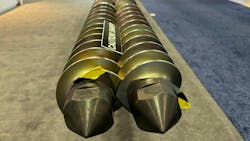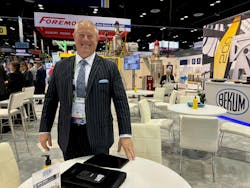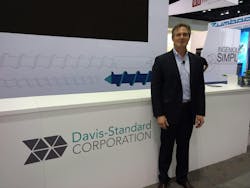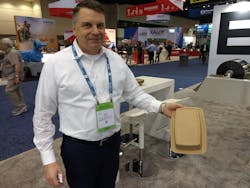Machinery OEMs hope economic picture is brightening
By Karen Hanna, Bruce Geiselman and Lynne Sherwin
Resilience and adaptation were on display among processing machinery OEMs gathered for NPE2024, three years after the show was forced to cancel due to the COVID-19 pandemic.
For some, the show’s return was punctuated by good news — as companies touted new technologies and visions for future growth, with manufacturing bases moving closer to buyers and users. But for others, the show came amid persistent struggles, mired in the economic turbulence of the last few years.
Buoying hopes among participants was the oft-expressed sentiment that visitors seemed serious when they swung by equipment booths to check out the wares at NPE in May in Orlando, Fla.
While the Plastics Industry Association (PLASTICS) reported total attendance of over 50,000 registrants — a dip of several thousand since the last NPE — the quality of the attendees was the factor that seemed to most impress representatives of OEMs.
“People didn’t just travel to travel,” Erik Eggen, sales manager of Chen Hsong Injection Molding Machines & Apex Robots, said in June, when he still was working his way through leads. Instead, he and others said, they appeared to be motivated shoppers.
Global issues
For manufacturers across many categories, the sight of shoppers willing to unclench their wallets is a welcome revelation.
In his most recent synopsis of economic factors, Perc Pineda, chief economist for the Plastics Industry Association (PLASTICS) observed that capital expenditures (CapEx) for nonresidential investments rose 3.3 percent in the first quarter of this year — better than the rate of 2.9 percent that was expected. Meanwhile, investment spending on structures rose 0.4 percent — slightly better than the forecast of a moribund 0.1 percent. Investment spending on intellectual property products showed better gains — 7.9 percent, significantly higher than the forecast of 5.4 percent.
“Given that CapEx is a leading economic indicator, its growth suggests a cautiously favorable outlook for sectors that include the end markets of the plastics industry,” Pineda wrote.
However, the June assessment comes on the heels of his first-quarter analysis, when the economist wrote, “It is common to see lower shipments in the first quarter of each year. Long-term data confirms this consistent pattern. Accounting for such seasonality, shipments decreased by 8.5 percent quarter-over-quarter. This time, plastics machinery suppliers reacted in alignment with the overall pullback in the macroeconomy and a still high-interest-rate environment.”
According to the report, the values of single-screw extruders shipped in the first quarter were down 47.7 percent over the previous quarter and 23.4 percent year-over-year. Meanwhile, the shipment values of IMMs fell by 33.8 percent and 24.9 percent, and twin-screw extruders fell 7 percent and 17 percent, respectively, over the same time periods.
Rough waters
Companies representing a variety of industries reported economic challenges.
“If you look at the statistics published by the Plastics Industry Association, clearly all machinery manufacturers — injection molding, blow molding, extrusion, everyone — [were] negatively impacted, unfortunately,” said Steve London, who, as Bekum America Corp. president and COO, served as chairman of NPE2024. “We are seeing some recovery. We are seeing a lot of end users who are taking [lessons from] the supply chain crisis and becoming producers of containers, when they didn't do that before.”
But it’s not that manufacturers are looking to take chances.
"The economy has spooked a few people to write a million-dollar check, if you will,” said Linda Campbell, VP of sales for Entek.
Of all the companies to acknowledge some struggles, few are in Illig’s situation — it recently filed for restructuring in Europe. The process is akin to Chapter 11 bankruptcy in the U.S.
However, Erik Hemgesberg, VP of the company’s thermoforming and packaging systems business unit, still voiced optimism.
“We are in Chapter 11 now, since four weeks,” he said at the show. “So this, I think this clearly proves where we are in terms of the economy. But we'll still be confident that we quickly resolve this topic and that we’re back as normal in a few weeks.”
Among other companies releasing economic updates at NPE were Davis-Standard and injection molding heavyweights Arburg, Wittmann and Engel.
Davis-Standard CEO Giovanni Spitale said his company is cutting back a little.
“We’ve had to do some minor things with variable costs to counter a little bit of offsets in demand. And we’ve taken the opportunity in this period of relatively low production to consolidate our Yakima, Wash., facility and Connecticut, for strategic reasons,” he said.
Among injection molding machine (IMM) makers, Arburg acknowledged one of the biggest declines.
In 2023, the company saw revenues of roughly $835 million, a decline of 11 percent over the previous year, said Guido Frohnhaus, managing director of technology and engineering for Arburg GmbH + Co. KG. U.S. orders from the first quarter of 2023 to this year also slumped.
“Unfortunately, there is no sign of a significant improvement in the short term,” Frohnhaus said.
Meanwhile, Stefan Engleder, CEO of the Engel Group, reported the company’s global turnover was down 6 percent, down to around 1.6 billion euros [about $1.7 billion].
“This is actually not too bad,” he said.
Wittmann Group President Michael Wittmann also delivered a mixed report on behalf of the IMM and auxiliary equipment supplier:
“You can see that we had last year a rather good year, 431 million euros of revenue [about $461.1 million]. That's our best year — 431 million. ... The last couple of years actually have been quite troublesome for us. And for this year, we are seeing a little bit of a drop.”
Speaking at his first NPE as president of Wittmann USA, Sonny Morneault said his company went into the year with slightly lower budget expectations, which it appears poised to meet.
Torrent of tumult
Economic stresses stem from a variety of sources.
“I’ve been in this business for nearly 40 years now, and this is a really unique set of circumstances that I don’t think we’ve ever seen before,” Sowden said.
In its press release about its restructuring, Illig cited international conflicts and energy costs, among other issues.
Inflation also bears significant blame.
“We had many years with almost zero interest,” said Karl Stöger, CEO of extrusion technology makers SML. “People were used to that, and money is for free. If I need $5 million as a loan, I can get it and hardly pay any interest. So, this, of course, helps investment decisions. So, then, when suddenly within a couple of months, it was raised from zero to 5 percent in the U.S. and 4 percent in Europe, of course, this was not helping investment decisions. They used to get the money or the loans for free. ‘And now I have to pay for the money. I have to recalculate. Is this project still viable economically?’ ”
Fred Piercy, president and GM of R&B Plastics Machinery LLC, echoed Stöger’s sentiments.
“Yeah, the capital is tight, interest rates high. ...” he said. “I’m surprised it’s not more depressed than it is, to be quite honest.”
Capital costs present special restrictions on the ceiling for companies still starting up, noted Mark Jones, director of support services for North America for SML.
But existing companies still will buy new machinery — if they must have it, he said.
On the other hand, such conditions have made adapting existing machinery a more attractive option, Entek’s Campbell noted.
“We are very busy with retrofit projects,” she said. “So we’re seeing companies where maybe some of their product lines have slowed down, they’re investing in changing the footprint of their current assets, to be able to bring on different product lines without buying new equipment.”
Evolving demand
Representatives for OEMs provided a kaleidoscope of reactions when asked which markets are creating the most drag on their companies.
One area of agreement: The demand spike seen during the pandemic for certain products, like outdoor recreational equipment, is over. And a lot of companies that rode the pandemic wave now have more capacity than they’re using, with no need for new machines.
Several OEMs said the automotive market’s continuing stops and starts have staggered the economic prospects of them and their customers. That’s especially true because of the uncertainty surrounding the transition to electric vehicles, Arburg’s Frohnhaus said.
“They’re hanging on a thread, and we’re hanging on their thread,” said Ryan Pysarchik, president of Gluco Multiplas.
Engleder also cited the market’s struggles, but said he has seen some manufacturers reshore work as a result.
Illig’s Hemgesberg pointed to another source of troubles: “This year is a little bit weaker in the medical application industry.”
But a communications representative for the Absolute Group of Companies reported the medical market was a source of stability for the injection molding machine and automation congomerate.
“We’re healthy, we’re actually keeping it steady. We’re being a little more selective in hiring,” said Nate Smith, co-owner of the Absolute Group.
Whatever the source of the trouble, Pysarchik said he believes the malaise is widespread.
Without calling the current doldrums a recession, he conceded that whatever it is, “It is affecting all of us.”
Cutting travel time
The impact of the economic disruption has created an opportunity to pursue an approach that’s long been discussed by workers, manufacturers and lawmakers alike: moving production closer to customers. Whether expanding or consolidating, OEMs are taking stock of what home looks like.
Several companies are gazing out across the Pacific and Atlantic oceans — no longer tethered to the simple economics of labor costs. Instead, inflation, the logistical logjams of recent years and regulatory challenges have spurred the desire to set up home bases in multiple places.
Having a diverse market portfolio can be an advantage, said Cathy Rocheleau, co-owner of Rocheleau Tool & Die.
“We have customers in 40 countries. It’s a little bit slower in one area, it might be busier in another,” she said. “Sometimes, our smaller equipment might be busier in different markets, like the Caribbean, where they might not be looking for a high-production machine ... because they have a smaller number of people that they’re serving in their market.”
Meanwhile, several big players in the IMM world are looking to travel beyond their comfort zones.
“We see a trend that European companies, especially German, Austrian companies, are building a second footprint ... here in the United States or Mexico,” Engleder said at Engel’s NPE press conference.
For Arburg, it’s a case of “local-to-local.” Long known for its European roots, Arburg is moving beyond its birthplace in Lossburg, Germany. For example, Allrounders are tailored to customers’ needs in Rocky Hill, Conn.
“We will change our value strategy in general,” Frohnhaus said.
Having recently celebrated its centennial, Arburg is looking ahead.
“The global business environment is changing so much that the very successful model we had, over the next 100 years we have to alter it,” he said.
That outlook finds analogs among other overseas companies.
While it still is experiencing a downturn in Europe, Engel has seen significant growth in the U.S., Mexico and Canada, Engleder said.
Half the company’s footprint remains in Europe, but the company is putting greater emphasis on the Americas.
According to Vanessa Malena, at her first NPE as the president of Engel North America, Engel has split into three business segments under one umbrella: Engel Americas, Engel Asia and Engel Europe. At NPE, the company was preparing to open its 10th and newest production facility, in Queretaro, Mexico.
The new facility’s capacity will benefit customers in two hemispheres, with the goal of supplying the TI and e-mac IMM lines and automation throughout the Americas.
Additionally, the company announced earlier this year it had increased its workforce by more than 50 employees over the previous year, leading to a record-breaking number of over 260 employees in the U.S. and Canada.
“Let’s hope that the market needs this additional capacity soon,” Engleder said.
Varying conditions across the globe inform companies’ evolving strategies.
Leaders at both Arburg and Wittmann noted they most recently have encountered smoother sailing in the U.S. than in Europe.
At his first NPE as president and CEO of Arburg Inc. in the U.S., Martin Baumann noted there have been no mass layoffs in U.S.
“Our customers in the USA and [the] Americas are for the most part running machines at reasonable capacity utilization,” he said.
That experience seemed to mirror Wittmann’s.
“And I really have to say one thing is that the U.S. has become our biggest market; in the meantime, Germany has dropped down to second place,” Wittmann said of his company, which last year posted record U.S. revenues of $90 million.
Across the Atlantic, he said, “The economy in Europe is not doing great.” Wittmann’s facility in Kottingbrunn, Austria, is running at just 70 percent of normal capacity.
The company also has to cope with a labyrinth of shifting rules.
“The EU has great ideas, a lot of regulations,” Wittmann said during his company’s press conference. “And, when it comes to the end consumer — and there is some criticism about it — because they [realize] it becomes more expensive, the EU has a tendency then to delay the introduction of regulations. So we don’t know exactly when it [will] happen again with [regulations for] 2026, which is coming up very quickly. But for us, actually, it’s just important that we are not [just] in Europe; actually, we are a little bit outside.”
With labor costs increasing significantly in Europe, Wittmann is expanding its focus beyond Austria, where inflation has been especially high, and expanding into Hungary and Turkey. Work in Turkey is especially important, as Wittmann sees it as a hub for exports by truck — a response in recent years to the challenges of obtaining containers for shipment overwater.
The company has shifted manufacturing of its feeders, loaders and dryers to Turkey, and TCUs to Hungary, along with some IMMs.
“The Austrian market is that the high inflation affects us more than many other countries, even in Europe. And it has to do actually with the practice of [increasing] the labor into wages by inflation, plus what is collected into productivity gains, because we had rather high inflation. Austria [has] the third-highest inflation right now. ... That means actually that our labor costs are increasing dramatically,” Wittmann said.
Overall, the company now has 36 facilities in six countries.
On the other side of the world, LS Mtron also is looking toward growth, eyeing a 20-percent U.S. market share in the years to come, that’s meant big investments in North America, with a new U.S. technical center in Palestine, Texas, joining facilities in Wood Dale, Ill., and Duluth, Ga. The new facility will produce the company’s line of LS Tractors, and will also serve as a demonstration center and stocking point for the company’s IMM business.
So far, LS Mtron has grown market share from 1.5 percent in 2018 to 7.5 percent in 2023.
“In North America, it’s always the question of every molder is, ‘Where is your support coming from?’ ” said Paul Caprio, president of LS Mtron Injection Molding Machines USA.
The company is able to supply most of its machines within 100 days – evidence of the robust network it has built up.
In addition, as South Korea’s top IMM manufacturer, it is expanding in its home country with a new $12 million IMM production facility in Jinju.
The Jinju factory’s added production “is particularly important to meeting our strategic goal of increasing our already-growing footprint throughout North America,” said Peter Gardner, president of the U.S subsidiary of the multinational company.
Like Engel, it’s making gains in Mexico, too. LS Mtron Mexico recently opened its headquarters in Monterrey, with service offices in Tijuana and Queretaro — the same locale as Engel.
Clearing skies
Whether they’ve suffered through layoffs or simply slogged ahead through inflation and uncertainty, representatives of companies that make machines expressed consensus around one economic truth: The bad times can’t last.
Gluco’s Pysarchik said he believed the industry would have already hit the pivot: “We were expecting much more push at the end of ’23, and it waited till 2024.”
Joe Kendzulak, executive technical advisor, GM and instructor for Nissei America, said things have stabilized since the pandemic. Piercy, of R&B Plastics Machinery, said he believes there’s pent-up demand.
Meanwhile, Marko Koorneef, president of Boy Machines Inc., said he’s already seeing recovery.
“I’m starting to see a light at the end of the tunnel,” he said. “It seems to me actually in the last month and a half, two months, it’s starting to pick up.”
When that dam bursts, OEMs that came to NPE prepped for sales stand poised to make the best of their opportunities.
For example, Sowden said his company has established Kiefel Now — a fast-turnaround program suited for customers with urgent needs that have spurred them to invest imminently.
“One of the things that we see is that our customers’ purchasing horizons have really shortened. We don’t see a lot of speculative investment. We see a lot of urgent investment, where someone has a project, they need a machine,” he said.
In just a week or two, Kiefel can supply a thermoforming machine to a customer — ensuring that the manufacturer can seize on an order, rather than lose it to a rival.
The company, like many other OEMs, is ready to roll.
As NPE chairman London characterized the mood of the show: “People are pretty positive and pumped up.”
About the Author
Karen Hanna
Senior Staff Reporter
Senior Staff Reporter Karen Hanna covers injection molding, molds and tooling, processors, workforce and other topics, and writes features including In Other Words and Problem Solved for Plastics Machinery & Manufacturing, Plastics Recycling and The Journal of Blow Molding. She has more than 15 years of experience in daily and magazine journalism.
Bruce Geiselman
Senior Staff Reporter Bruce Geiselman covers extrusion, blow molding, additive manufacturing, automation and end markets including automotive and packaging. He also writes features, including In Other Words and Problem Solved, for Plastics Machinery & Manufacturing, Plastics Recycling and The Journal of Blow Molding. He has extensive experience in daily and magazine journalism.
Lynne Sherwin
Managing Editor
Managing editor Lynne Sherwin handles day-to-day operations and coordinates production of Plastics Machinery & Manufacturing’s print magazine, website and social media presence, as well as Plastics Recycling and The Journal of Blow Molding. She also writes features, including the annual machinery buying survey. She has more than 30 years of experience in daily and magazine journalism.



